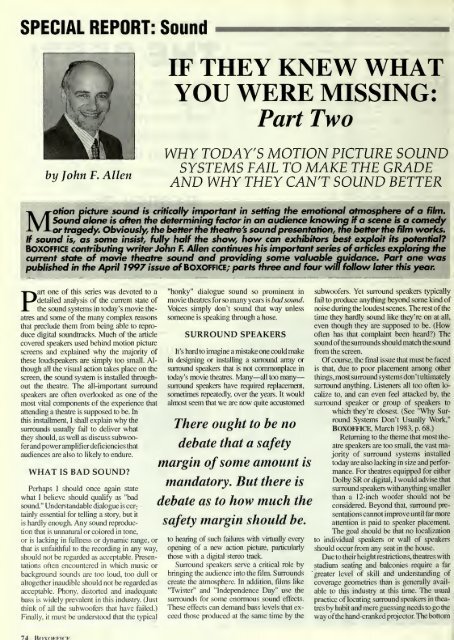Create successful ePaper yourself
Turn your PDF publications into a flip-book with our unique Google optimized e-Paper software.
74 RfiVfifFU-F.<br />
—<br />
SPECIAL REPORT: Sound<br />
Motion<br />
IF THEY KNEW WHAT<br />
YOU WERE MISSING:<br />
Part Two<br />
WHY TODAY'S MOTION PICTURE SOUND<br />
SYSTEMS FAIL TO MAKE THE GRADE<br />
AND WHY THEY CAN'T SOUND BETTER<br />
picture sound is critically important in setting the emotional atmosphere of a Him.<br />
Sauna alone is often the determining factor in an audience knowing W a scene is a comedy<br />
or tragedy. Obviously, Hie better the theatre's sound presentation, the better the film works.<br />
If sound is, as some insist, fully half the show, how can exhibitors best exploit its potential?<br />
BOXOFFICE contributing writer John F. Allen continues his important series of articles exploring the<br />
current state of movie theatre sound and providing some valuable auidance. Part one v^as<br />
published in the April 1997 issue of BOXOFFICE/ parts three and four will follow later this year.<br />
Part<br />
one of this<br />
series was devoted to a<br />
detailed analysis of the current state of<br />
the sound systems in today's movie theatres<br />
and some of the many complex reasons<br />
that preclude them from being able to reproduce<br />
digital soimdtracks. Much of the article<br />
covered speakers used behind motion picture<br />
screens and explained why the<br />
majority of<br />
these loudspeakers are simply too small. Although<br />
all the visual action takes place on the<br />
screen, the sound system is installed throughout<br />
the theatre. The all-important surround<br />
speakers are often overlooked as one of the<br />
most vital components of the experience that<br />
attending a theatre is suppxjsed to be. In<br />
this installment, I shall explain why the<br />
surrounds usually fail to deliver what<br />
they should, as well as discuss subwooferand<br />
power amplifier deficiencies that<br />
audiences are also to likely to endure.<br />
WHAT IS BAD SOUND?<br />
Perhaps 1 should once again state<br />
what 1 believe should qualify as "bad<br />
sound." Understandable dialogue is cef:<br />
tainly essential for telling a story, but it<br />
is hardly enough. Any sound reproduction<br />
that is unnatural or colored in tone,<br />
or is lacking in fullness or dynamic range, or<br />
that is unfaithful to the recording in any way,<br />
should not be regarded as acceptable. Pre,sentations<br />
often encountered in which music or<br />
background sounds are ttxj loud, too dull or<br />
altogether inaudible should not be regarded as<br />
acceptable. Phony, distorted and inadequate<br />
bass is widely prevalent in this industry. (Just<br />
think of all the subwoofers that have failed.)<br />
Finally, it must be undersiotxl that the typical<br />
"honky" dialogue sound so prominent in<br />
movie theatres for so many years is bad sound.<br />
Voices simply don't sound that way unless<br />
someone is speaking through a hose.<br />
SURROUND SPEAKERS<br />
It's hard to imagine a mistake one could make<br />
in designing or installing a surround array or<br />
sunound speakei^ that is not commonplace in<br />
today's movie theatres. Many—^all too many<br />
surround speakers have required replacement,<br />
sometimes repeatedly, over the years. It would<br />
almost seem that we are now quite accustomed<br />
There ought to be no<br />
debate that a safety<br />
margin of some amount is<br />
mandatory. But there is<br />
debate as to how much the<br />
safety margin should be.<br />
to hearing of such failures with virtually every<br />
opening of a new action picture, particularly<br />
those with a digital stereo track.<br />
Surround speakers serve a critical role by<br />
bringing the audience into the film. Surrounds<br />
create the atmosphere. In addition, films like<br />
"Twister"<br />
and "Independence Day" use the<br />
surrounds for some enormous sound effects.<br />
These effects can demand bass levels that exceed<br />
those pixxluced at the same lime by the<br />
subwoofers. Yet surround speakers typically<br />
fail to produce anything beyond some kind of<br />
noise during the loudest scenes. The rest of the<br />
time they hardly sound like they're on at all,<br />
even though they are supposed to be. (How<br />
often has that complaint been heard?) The<br />
sound ofthe surrounds should match the sound<br />
from the screen.<br />
Of course, the final issue that must be faced<br />
is that, due to poor placement among other<br />
things, most surround systems don' t ultimately<br />
surround anything. Listeners all too often localize<br />
to, and can even feel attacked by, the<br />
surround speaker or group of speakers to<br />
which they're closest. (See "Why Surround<br />
Systems Don't Usually Work,"<br />
BOXOFFICE, March 1983, p. 68.)<br />
Returning to the theme that most theatre<br />
speakers are too small, the vast majority<br />
of surround systems installed<br />
today are also lacking in size and performance.<br />
For theatres equipped for either<br />
Dolby SR or digital, 1 would advise that<br />
surround speakers with anything smaller<br />
than a 12-inch woofer should not be<br />
considered. Beyond that, surround presentations<br />
cannot improve until far more<br />
attention is paid to speaker placement<br />
The goal should be that no locali?.ation<br />
to individual speakers or wall of speakers<br />
should occur finom any seat in the house.<br />
Due to their height restrictions, theatres with<br />
stadium seating and balconies require a far<br />
greater level of skill and understanding of<br />
coverage geometries than is generally available<br />
to this industry at this time. The usual<br />
practice of locating surround speakers in theatres<br />
by habit and mere guessing needs to go the<br />
way of the hand-cranked projector. The bottom

















